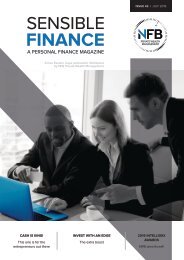NVFH 2020 Integrated Annual Report
You also want an ePaper? Increase the reach of your titles
YUMPU automatically turns print PDFs into web optimized ePapers that Google loves.
NVest Financial Holdings Limited and its subsidiaries | (Registration number 2008/015990/06)
Annual Financial Statements for the year ended 29 February 2020
Accounting Policies [continued]
1.14 Revenue from contracts with customers [continued]
Revenue is earned and recognised as follows:
Brokerage income - this income is earned when stockbroking
services are provided for shares bought and sold on behalf of
a client and recognised at the time of the transaction.
Commission income - initial/take on commission comprises
commissions earned on advice on investment and insurance
products and the group recognises revenue when the
transaction that gives rise to the revenue is concluded with
the client. The group is entitled to this revenue irrespective
of the decisions the client makes in the future. Ongoing
monthly/annuity commission is earned and this is based on
the value of the respective underlying investment portfolio,
and recognised as it is earned on a monthly basis as this is
when the service is performed.
Administration fees - are fees earned for administration and
maintenance of share and investment portfolios (charged
and settled on a quarterly basis), and for the administration
of deceased estates.
Management fees - are fees received for the monthly
management of investment portfolios (based on the value
of assets under management), property portfolios and trusts.
Revenue is recognised each month as the services are
performed.
Practical Expedient
The group has taken advantage of the practical exemption
not to account for significant financing components where
the time difference between receiving consideration and
transferring control of services to its customer is one year
or less.
1.15 Cost of sales
The related cost of providing services recognised as revenue
in the current period is included in cost of sales.
1.16 Borrowing costs
Borrowing costs are recognised as an expense in the period
in which they are incurred. There are no qualifying assets in
the group.
1.17 Earnings per share
Earnings per share is calculated by taking the profit after
taxation attributable to the equity holders of the parent and
dividing this by the weighted average number of shares in
issue. Diluted earnings per share adjusts the figures calculated
in the basic earnings per share by the effects of instruments
which dilute the basic earnings per share figure. Headline
earnings per share is calculated in terms of the requirements
set out in Circular 01/2019 issued by the JSE.
1.18 Segmental reporting
IFRS 8 requires operating segments to be identified on the
basis of internal reports that are regularly reviewed by the
chief operating decision maker (considered to be the
executive members of the board).
Management currently identifies five operating segments,
being operations in the Republic of South Africa divided into
insurance broking, wealth management, administration of
estates and trusts, property services and investments. Each
operating segment is monitored separately and strategic
decisions are made on the basis of segment operating results.
1.19 Net asset value and net tangible asset
value per share
It is company policy to disclose net asset value and net
tangible asset value per share.
In determining net asset value and net tangible asset per
share, the total number of shares in issue at year end was
used as denominator. For net tangible asset value per share,
the goodwill was excluded from the numerator.
2. Changes in accounting policy
The annual financial statements have been prepared in
accordance with International Financial Reporting Standards
on a basis consistent with the prior year except for the
adoption of the following new or revised standards.
Application of IFRS 16 Leases
In the current year, the group has adopted IFRS 16 Leases
(as issued by the IASB in January 2016) with the date of initial
application being 01 March 2019. IFRS 16 replaces IAS
17 Leases, IFRIC 4 Determining whether an Arrangement
contains a lease, SIC-15 Operating Leases - Incentives and
SIC 27 - Evaluating the Substance of Transactions Involving
the Legal Form of a Lease.
IFRS 16 introduces new or amended requirements with
respect to lease accounting. It introduces significant
changes to the lessee accounting by removing the
distinction between operating and finance leases and
requiring the recognition of a right-of-use asset and a
lease liability at the lease commencement for all leases,
except for short-term leases and leases of low value
assets. In contrast to lessee accounting, the requirements
for lessor accounting have remained largely unchanged.
Details of these new requirements are described in the
accounting policy for leases. The impact of the adoption
of IFRS 16 on the company’s annual financial statements
is described below.
NVest Financial Holdings Limited | INTEGRATED ANNUAL REPORT 2020 93






